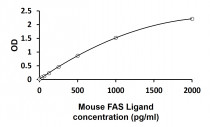ARG81643
Mouse CD178 / FAS Ligand ELISA Kit
Mouse CD178 / FAS Ligand ELISA Kit for ELISA and Mouse
Component
| Cat No | Component Name | Package | Temp |
|---|---|---|---|
| ARG81643-001 | Antibody-coated microplate | 8 X 12 strips | 4°C. Unused strips should be sealed tightly in the air-tight pouch. |
| ARG81643-002 | Standard | 2 X 10 ng/vial | 4°C |
| ARG81643-003 | Standard/Sample diluent | 30 ml (Ready to use) | 4°C |
| ARG81643-004 | Antibody conjugate concentrate (100X) | 1 vial (100 µl) | 4°C |
| ARG81643-005 | Antibody diluent buffer | 12 ml (Ready to use) | 4°C |
| ARG81643-006 | HRP-Streptavidin concentrate (100X) | 1 vial (100 µl) | 4°C |
| ARG81643-007 | HRP-Streptavidin diluent buffer | 12 ml (Ready to use) | 4°C |
| ARG81643-008 | 25X Wash buffer | 20 ml | 4°C |
| ARG81643-009 | TMB substrate | 10 ml (Ready to use) | 4°C (Protect from light) |
| ARG81643-010 | STOP solution | 10 ml (Ready to use) | 4°C |
| ARG81643-011 | Plate sealer | 4 strips | Room temperature |
Overview
| Product Description | ARG81643 Mouse CD178 / FAS Ligand ELISA Kit is an Enzyme Immunoassay kit for the quantification of Mouse CD178 / FAS Ligand in serum, plasma (heparin, EDTA, citrate) and cell culture supernatants. |
|---|---|
| Tested Reactivity | Ms |
| Tested Application | ELISA |
| Specificity | There is no detectable cross-reactivity with other relevant proteins. |
| Target Name | CD178 / Fas Ligand |
| Conjugation | HRP |
| Conjugation Note | Substrate: TMB and read at 450 nm. |
| Sensitivity | 15.6 pg/ml |
| Sample Type | Serum, plasma (heparin, EDTA, citrate) and cell culture supernatants. |
| Standard Range | 31.2 - 2000 pg/ml |
| Sample Volume | 100 µl |
| Precision | Intra-Assay CV: 5.8%; Inter-Assay CV: 6.7% |
| Alternate Names | FasL ICD; SPPL2A-processed FasL form; Apoptosis antigen ligand; CD95 ligand; CD178; Fas antigen ligand; CD95-L; Receptor-binding FasL ectodomain; FasL; SPA; TNFSF6; CD95L; FASL; Fas ligand; APTL; APT1LG1; ALPS1B; sFasL; Soluble Fas ligand; Tumor necrosis factor ligand superfamily member 6; APL; CD antigen CD178 |
Application Instructions
| Assay Time | ~ 5 hours |
|---|
Properties
| Form | 96 well |
|---|---|
| Storage Instruction | Store the kit at 2-8°C. Keep microplate wells sealed in a dry bag with desiccants. Do not expose test reagents to heat, sun or strong light during storage and usage. Please refer to the product user manual for detail temperatures of the components. |
| Note | For laboratory research only, not for drug, diagnostic or other use. |
Bioinformation
| Gene Symbol | FASLG |
|---|---|
| Gene Full Name | Fas ligand (TNF superfamily, member 6) |
| Background | This gene is a member of the tumor necrosis factor superfamily. The primary function of the encoded transmembrane protein is the induction of apoptosis triggered by binding to FAS. The FAS/FASLG signaling pathway is essential for immune system regulation, including activation-induced cell death (AICD) of T cells and cytotoxic T lymphocyte induced cell death. It has also been implicated in the progression of several cancers. Defects in this gene may be related to some cases of systemic lupus erythematosus (SLE). Alternatively spliced transcript variants have been described. [provided by RefSeq, Nov 2014] |
| Function | Cytokine that binds to TNFRSF6/FAS, a receptor that transduces the apoptotic signal into cells. May be involved in cytotoxic T-cell mediated apoptosis and in T-cell development. TNFRSF6/FAS-mediated apoptosis may have a role in the induction of peripheral tolerance, in the antigen-stimulated suicide of mature T-cells, or both. Binding to the decoy receptor TNFRSF6B/DcR3 modulates its effects. The FasL intracellular domain (FasL ICD) cytoplasmic form induces gene transcription inhibition. [UniProt] |
| Highlight | Related products: CD178 antibodies; CD178 ELISA Kits; Related news: Detecting MMPs and their non-ECM substrates New ELISA data calculation tool: Simplify the ELISA analysis by GainData |
| PTM | The soluble form derives from the membrane form by proteolytic processing. The membrane-bound form undergoes two successive intramembrane proteolytic cleavages. The first one is processed by ADAM10 producing an N-terminal fragment, which lacks the receptor-binding extracellular domain. This ADAM10-processed FasL (FasL APL) remnant form is still membrane anchored and further processed by SPPL2A that liberates the FasL intracellular domain (FasL ICD). FasL shedding by ADAM10 is a prerequisite for subsequent intramembrane cleavage by SPPL2A in T-cells. N-glycosylated (PubMed:9228058). Glycosylation enhances apoptotic activity (PubMed:27806260). Phosphorylated by FGR on tyrosine residues; this is required for ubiquitination and subsequent internalization. Monoubiquitinated. [UniProt] |
Images (1) Click the Picture to Zoom In
| Title | Download Link |
|---|---|
| ARG81643 Mouse FAS Ligand ELISA Kit User manual |
 Download Download
|






